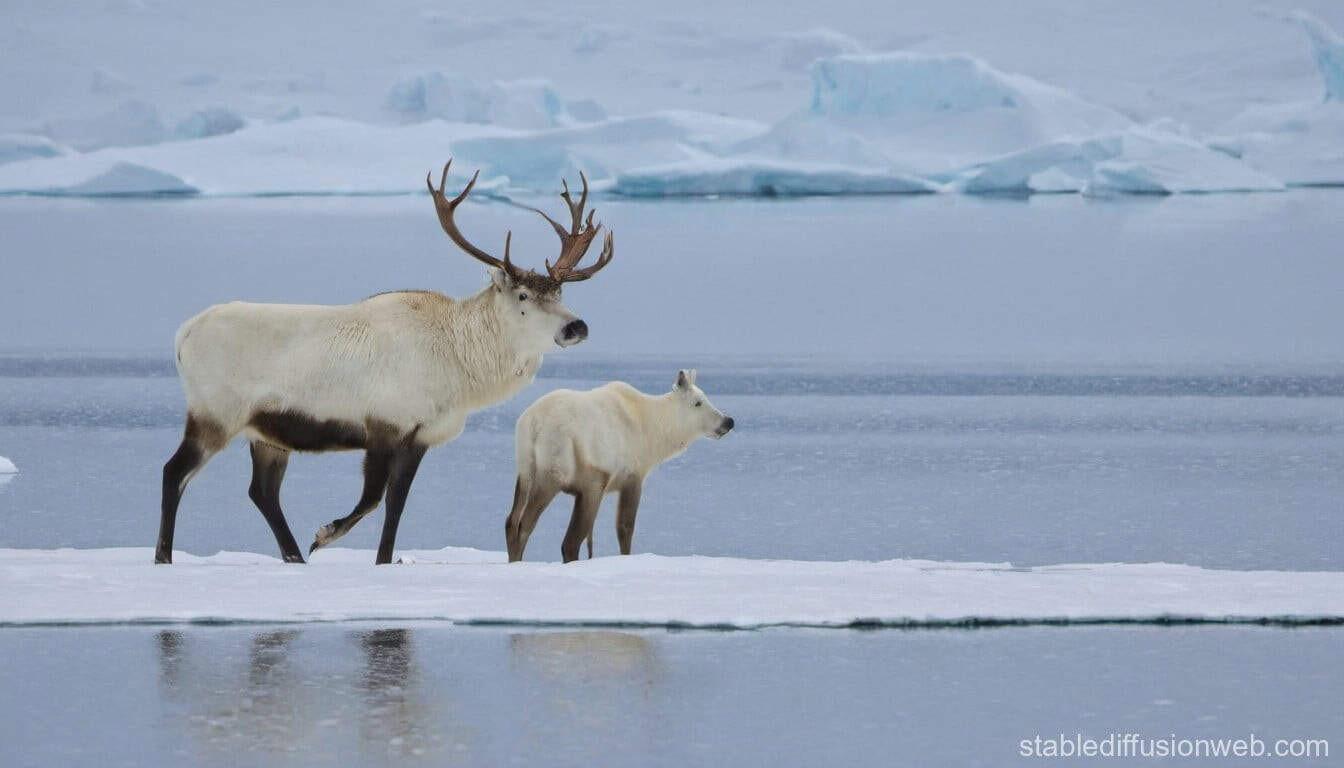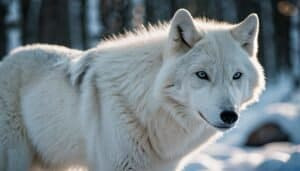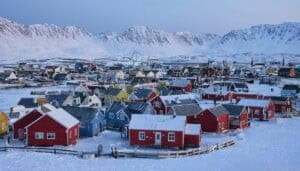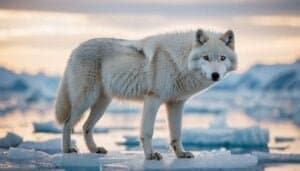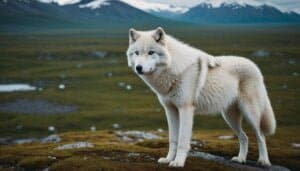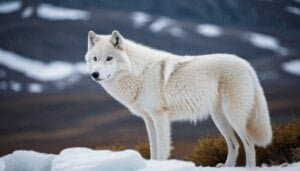Introduction
Arctic wolves play a crucial role in the dynamic environment of the Arctic, particularly during the migration seasons of various animal species
This article delves into the multifaceted relationship between Arctic wolves and migrating animals, examining their predatory behavior, the impact on migration patterns, and the strategies they employ for survival
Additionally, we’ll explore scientific studies that shed light on these interactions and consider the effects of climate change on both Arctic wolves and their prey
The Role of Arctic Wolves in Animal Migrations
Arctic wolves, scientifically known as Canis lupus arctos, are a subspecies of the gray wolf adapted to the harsh conditions of the Arctic. These apex predators are integral to the Arctic ecosystem, particularly during animal migration periods
Their role goes beyond predation, influencing the behavior and survival of various migrating species and maintaining ecological balance.
Predatory Behavior and Its Effects
Arctic wolves are skilled hunters, relying on their keen senses and cooperative pack behavior to track and capture prey. During migration periods, their predatory behavior becomes even more pronounced. They primarily target weak, sick, or young animals, which are easier to catch
This selective predation helps control the population of migrating species, such as caribou and musk oxen, ensuring that only the strongest individuals survive to reproduce. This natural selection process is crucial for maintaining healthy and resilient populations
The presence of Arctic wolves also induces behavioral changes in their prey. Migrating animals often alter their routes or increase their vigilance to avoid wolf packs
These adaptations can lead to a more dynamic and varied migration pattern, which can be beneficial for the vegetation and other wildlife in the region. By preventing overgrazing in certain areas, wolves indirectly contribute to the health of the tundra ecosystem
Interaction with Migrating Prey
Arctic wolves have a profound impact on the migrating animals they hunt. Caribou, one of their primary prey, undertake long migrations across the Arctic tundra in search of food and breeding grounds
The wolves follow these herds, preying on the individuals that lag behind. This predation pressure ensures that the caribou remain vigilant and mobile, which is essential for their survival in such a challenging environment
Interestingly, the relationship between Arctic wolves and their prey is not solely adversarial. Some studies suggest a form of co-evolution, where the presence of wolves has shaped the migration patterns and behaviors of caribou over generations. This predator-prey dynamic is a key component of the Arctic food web, highlighting the interconnectedness of species within this ecosystem
Ecological Significance
The ecological significance of Arctic wolves extends beyond their role as predators. By controlling the population of herbivores like caribou and musk oxen, wolves help maintain the balance between plant and animal life in the Arctic
This balance is essential for the sustainability of the tundra ecosystem, as overgrazing by herbivores can lead to the degradation of vegetation and soil quality
Moreover, the carcasses of animals killed by wolves provide food for a variety of scavengers, including birds and smaller mammals. This redistribution of nutrients supports a diverse range of species and contributes to the overall biodiversity of the Arctic region. In this way, Arctic wolves act as keystone species, with their presence and activities having far-reaching effects on the ecosystem
The role of Arctic wolves in animal migrations is a testament to the complexity and interdependence of natural systems
Their predatory behavior, interactions with prey, and ecological impact illustrate the delicate balance that sustains life in the Arctic. As we continue to study and understand these dynamics, it becomes clear that protecting Arctic wolves and their habitat is vital for the health of the entire Arctic ecosystem
Impact of Arctic Wolves on Migration Patterns
Arctic wolves have a significant impact on the migration patterns of the species they prey upon. These apex predators play a vital role in shaping the behaviors and routes of migrating animals, influencing the dynamics of the Arctic ecosystem
Disruption and Adaptation in Prey
The presence of Arctic wolves often leads to disruptions in the migration patterns of their prey. Caribou, for instance, are known to alter their routes to avoid wolf packs. This behavior is an adaptive response to predation pressure
By changing their migration paths, caribou can reduce the likelihood of encountering wolves, increasing their chances of survival. This constant need for adaptation can lead to more resilient and flexible herds, better equipped to handle the challenges of the Arctic environment
Additionally, musk oxen, another primary prey for Arctic wolves, have developed defensive behaviors in response to wolf predation. They often form protective circles, with adults facing outward and calves in the center, to fend off wolf attacks. These behavioral adaptations highlight the influence of Arctic wolves on the survival strategies of migrating species
Influence on Caribou and Musk Oxen
Arctic wolves exert considerable influence on the migration patterns of caribou and musk oxen. For caribou, the presence of wolves can dictate the timing and speed of their migrations
Caribou tend to move more quickly and in larger groups when they sense the presence of wolves, a strategy that reduces individual risk. This increased pace and grouping can affect the overall energy expenditure of the herd, impacting their health and reproductive success
Musk oxen, with their more static nature, respond differently. They are less likely to alter their migration routes but instead focus on defensive formations and strategic use of the terrain to avoid wolf predation. These behaviors show the varying impacts of Arctic wolves on different species, highlighting the predators’ role in shaping the ecological landscape
Case Studies and Observations
Several case studies and field observations provide insight into the impact of Arctic wolves on migration patterns
Research conducted in Canada and Greenland has shown that caribou herds subjected to high wolf predation pressure are more likely to alter their routes and exhibit increased vigilance. These behavioral changes are crucial for understanding the broader ecological effects of wolf predation
One notable study conducted in the Canadian Arctic observed that caribou herds with frequent wolf encounters displayed more erratic and fragmented migration patterns compared to herds in areas with fewer wolves. This fragmentation can have cascading effects on the ecosystem, influencing vegetation patterns and the distribution of other wildlife species
Another study in Greenland focused on the interactions between musk oxen and Arctic wolves. Researchers found that musk oxen herds near wolf territories exhibited more cohesive and defensive behaviors, leading to lower predation rates. These findings underscore the importance of predator-prey dynamics in shaping the migration and behavior of Arctic animals
Implications for Conservation
Understanding the impact of Arctic wolves on migration patterns is crucial for conservation efforts. Protecting wolf populations ensures the continuation of these natural behaviors and the ecological balance they maintain. Conservation strategies must consider the role of Arctic wolves in regulating prey populations and influencing migration dynamics
Efforts to conserve caribou and musk oxen must also account for the presence of wolves. By protecting the habitats of both predators and prey, we can preserve the intricate relationships that define the Arctic ecosystem. Research and monitoring programs are essential for tracking these interactions and informing effective conservation policies
The impact of Arctic wolves on migration patterns is a complex interplay of predation, adaptation, and ecological balance. Their presence shapes the behaviors and routes of migrating animals, highlighting the interconnectedness of the Arctic ecosystem. By studying and preserving these dynamics, we can better understand and protect the fragile environment of the Arctic
Survival Strategies of Arctic Wolves During Migrations
Arctic wolves exhibit a range of survival strategies during animal migrations, ensuring their sustenance and the continuation of their packs. These strategies encompass their hunting techniques, pack dynamics, and seasonal adaptations that are finely tuned to the harsh Arctic environment
Hunting Techniques and Pack Dynamics
Arctic wolves rely on their sophisticated hunting techniques and tightly knit pack dynamics to secure food during migrations
Their hunting strategies are highly coordinated, often involving multiple members of the pack working together to isolate and take down prey. This cooperative hunting allows them to tackle larger and more challenging targets, such as caribou and musk oxen
A typical hunting scenario involves wolves identifying a potential prey group and then employing a combination of stealth, speed, and endurance to chase and separate a weaker individual from the herd
The pack’s ability to communicate and strategize during the hunt is crucial for their success. This pack cohesion ensures that each member contributes to the hunt, whether through direct participation or by taking on supportive roles such as guarding the young or patrolling the territory
Pack dynamics play a significant role in the wolves’ survival. The social structure within a pack is hierarchical, with a dominant alpha pair leading the group. This leadership is essential for maintaining order and ensuring efficient coordination during hunts
The alpha wolves make critical decisions about when and where to hunt, guiding the pack through the challenges of the Arctic landscape
Seasonal Adaptations
Arctic wolves have developed a series of adaptations to survive the extreme seasonal variations in their environment
During the harsh winter months, when prey is scarcer and conditions are more severe, wolves rely on their thick fur and robust physique to endure the cold. Their white coats provide excellent camouflage in the snow, allowing them to approach prey unnoticed
In the summer, when the snow melts and the tundra becomes more accessible, wolves take advantage of the increased availability of prey. This period is crucial for building up fat reserves that will sustain them through the leaner winter months. The pack’s territory may expand during this time to cover areas with higher prey density, ensuring a consistent food supply
Reproductive strategies are also closely tied to the seasonal cycle. Pups are typically born in the spring, a time when food is more plentiful, increasing their chances of survival. The entire pack is involved in raising and protecting the young, demonstrating the importance of social bonds and cooperation in Arctic wolf packs
Nutritional Requirements
The nutritional requirements of Arctic wolves are demanding, especially during migration periods
Wolves need a diet rich in protein and fat to maintain their energy levels and overall health. Caribou and musk oxen, their primary prey, provide the necessary nutrients to sustain the wolves through the rigorous demands of their environment
During migration, the wolves must efficiently balance their energy expenditure with their caloric intake. Hunting large prey requires significant energy, so successful hunts are vital for the wolves’ survival. They often consume as much of their kill as possible, including organs and bones, to maximize their nutrient intake. This efficient use of resources is critical in an environment where food can be unpredictable and scarce
In times of food scarcity, Arctic wolves may also scavenge from carcasses left by other predators or from animals that have succumbed to the harsh conditions. This opportunistic feeding behavior ensures they can survive during lean periods, highlighting their adaptability and resilience
Environmental Challenges
The Arctic environment presents numerous challenges that Arctic wolves must navigate to survive
Harsh weather conditions, scarcity of prey, and competition with other predators are constant threats. Wolves have evolved to endure these challenges through physical and behavioral adaptations, such as their thick fur, strong pack cohesion, and strategic hunting techniques
Climate change poses a new set of challenges for Arctic wolves. As temperatures rise and ice patterns shift, the availability and distribution of prey may change, forcing wolves to adapt their hunting strategies and migration routes. Understanding and mitigating these impacts are crucial for the conservation of Arctic wolves and the broader ecosystem
The survival strategies of Arctic wolves during migrations are a testament to their adaptability and resilience. Through cooperative hunting, seasonal adaptations, and strategic use of resources, these apex predators thrive in one of the planet’s most challenging environments
Their ability to navigate the complexities of the Arctic ecosystem underscores the importance of preserving these remarkable animals and their habitats
Scientific Studies on Arctic Wolves and Migrations
Scientific research has provided invaluable insights into the behaviors and ecological roles of Arctic wolves, particularly concerning their interactions with migrating species. These studies employ a variety of methods and technologies to understand the complex dynamics between Arctic wolves and their environment
Research Methods and Technologies
Researchers use several methods to study Arctic wolves, including direct observation, tracking, and advanced technologies such as GPS collars and remote sensing
Direct observation involves fieldwork in the Arctic, where scientists track and document wolf behavior, hunting strategies, and interactions with prey. This method provides detailed, firsthand data but is limited by the harsh and remote nature of the Arctic environment
GPS collars are widely used to monitor the movements and behaviors of Arctic wolves. These collars transmit location data to researchers, allowing them to map migration routes, hunting territories, and pack dynamics over time. This technology provides a wealth of information about the spatial ecology of wolves and their prey, revealing patterns that would be difficult to observe through direct observation alone
Remote sensing technologies, including drones and satellite imagery, offer additional perspectives on Arctic wolf behavior and habitat use. Drones can capture high-resolution images and videos of wolf packs and their interactions with migrating herds, providing a bird’s-eye view of these dynamics
Satellite imagery can track changes in vegetation and ice cover, helping researchers understand how environmental factors influence wolf behavior and prey availability
Key Findings and Insights
Studies have revealed several key findings about the role of Arctic wolves in the ecosystem and their interactions with migrating species. One significant insight is the wolves’ impact on the population dynamics of their prey
By preying on weaker individuals, Arctic wolves help maintain the health and genetic diversity of caribou and musk oxen herds. This selective predation is crucial for the long-term viability of these species
Research has also highlighted the adaptability of Arctic wolves to changing environmental conditions. For example, studies have shown that wolves can adjust their hunting strategies and migration routes in response to variations in prey availability and climate conditions. This adaptability is essential for their survival in the rapidly changing Arctic environment
Another important finding is the role of Arctic wolves in nutrient cycling. The carcasses left behind by wolf kills provide food for a variety of scavengers, including birds and smaller mammals
This scavenging activity helps redistribute nutrients throughout the ecosystem, supporting a diverse array of species and contributing to the overall health of the tundra
Contributions to Conservation Efforts
Scientific studies on Arctic wolves have significant implications for conservation efforts
By understanding the wolves’ behaviors, population dynamics, and ecological roles, researchers can develop more effective strategies to protect these apex predators and their habitats. Conservation initiatives often focus on preserving the natural balance between predators and prey, ensuring that both groups can thrive
One key aspect of conservation is the protection of critical habitats used by Arctic wolves and their prey. By identifying and safeguarding these areas, conservationists can help maintain the ecological processes that support both wolves and migrating species. This approach often involves working with indigenous communities and other stakeholders to ensure that conservation efforts are culturally and economically sustainable
Additionally, research on the impacts of climate change on Arctic wolves is vital for developing adaptive management strategies. As the Arctic environment continues to change, understanding how these changes affect wolf populations and their prey can inform conservation policies that address the challenges posed by a warming climate
Long-term Monitoring and Future Research
Long-term monitoring is essential for tracking the health and stability of Arctic wolf populations and their ecosystems
Ongoing studies help researchers detect changes over time, identify emerging threats, and evaluate the effectiveness of conservation measures. Collaborative efforts between scientists, government agencies, and indigenous communities are crucial for the success of these monitoring programs
Future research will likely focus on the impacts of climate change, human activities, and other environmental stressors on Arctic wolves and their prey. Advances in technology, such as more sophisticated tracking devices and improved remote sensing techniques, will enhance our ability to study these complex interactions. By continuing to expand our knowledge, we can better protect the Arctic’s unique and fragile ecosystems
Scientific studies on Arctic wolves and migrations provide a deeper understanding of the intricate relationships within the Arctic ecosystem
Through innovative research methods and technologies, scientists uncover valuable insights that inform conservation efforts and highlight the importance of preserving these remarkable predators and their habitats
Arctic Wolves and Climate Change
Climate change poses significant challenges for Arctic wolves, impacting their habitat, prey availability, and overall survival. As the Arctic environment undergoes rapid transformation, understanding these impacts is crucial for developing effective conservation strategies
Effects of Warming Temperatures
Warming temperatures in the Arctic have led to a range of environmental changes, including the reduction of sea ice, thawing of permafrost, and shifts in vegetation patterns. These changes directly affect the habitat and hunting grounds of Arctic wolves
For example, the loss of sea ice reduces the availability of certain prey species that rely on ice-covered regions, forcing wolves to adapt their hunting strategies and explore new territories
Additionally, warmer temperatures can lead to more frequent and severe weather events, such as heavy rains and storms, which can disrupt the movements of both wolves and their prey. The increased unpredictability of weather patterns poses further challenges for Arctic wolves, as they must continuously adjust their behaviors and strategies to cope with these changes
Changes in Prey Availability
Climate change significantly influences the availability and distribution of prey species, which in turn affects Arctic wolves
For instance, shifts in caribou migration patterns due to changing vegetation and snow cover can alter the timing and routes of these migrations. As a result, wolves must adapt to these new patterns, potentially leading to increased energy expenditure and reduced hunting success
Musk oxen, another primary prey for Arctic wolves, are also affected by climate change. Warmer temperatures and changing vegetation can impact the health and population dynamics of musk oxen herds. As these prey species face additional stressors from the environment, their populations may decline, further challenging the wolves that depend on them for sustenance
Moreover, climate change can introduce new species into the Arctic ecosystem, creating additional competition for resources. Wolves may find themselves competing with other predators, such as bears, which can lead to increased conflict and reduced prey availability for all species involved
Long-term Projections and Conservation
Long-term projections for the Arctic indicate continued warming and further environmental changes
These projections highlight the need for proactive conservation efforts to ensure the survival of Arctic wolves and their ecosystems. Conservation strategies must consider the multifaceted impacts of climate change and address both immediate and long-term challenges
One critical aspect of conservation is habitat protection. Preserving and restoring key habitats used by Arctic wolves and their prey can help mitigate some of the adverse effects of climate change. This includes protecting migration corridors and breeding grounds, which are essential for the long-term viability of both wolves and their prey species
Adaptive management strategies are also crucial. These strategies involve continuously monitoring environmental conditions and wildlife populations, allowing conservationists to adjust their approaches based on the latest data and trends. By remaining flexible and responsive to changing conditions, conservation efforts can better support the resilience of Arctic wolves
Engaging with indigenous communities is another important component of effective conservation. Indigenous knowledge and practices offer valuable insights into the behaviors and needs of Arctic wildlife
Collaborative efforts that incorporate traditional knowledge and scientific research can enhance conservation strategies and ensure they are culturally and ecologically sustainable
Research and Monitoring Initiatives
Ongoing research and monitoring initiatives are vital for understanding the impacts of climate change on Arctic wolves. These efforts provide critical data on wolf populations, prey dynamics, and environmental conditions, informing conservation policies and actions
One notable initiative is the Arctic Wolf Research Program, which conducts long-term studies on wolf behavior, ecology, and population trends. By tracking wolf movements, prey interactions, and habitat use, researchers can identify key areas for conservation and develop targeted strategies to support wolf populations
Another important effort is the integration of climate models with wildlife studies. By combining data on temperature and precipitation patterns with ecological data, scientists can predict how future climate scenarios might impact Arctic wolves and their prey. This integrated approach helps identify potential risks and opportunities for conservation
Community Engagement and Education
Raising awareness about the impacts of climate change on Arctic wolves and the broader ecosystem is essential for garnering support for conservation efforts. Community engagement and education programs can inform the public about the challenges facing Arctic wildlife and inspire action to protect these species
Educational initiatives can include outreach to schools, public talks, and multimedia campaigns that highlight the importance of Arctic wolves and the threats posed by climate change. By fostering a deeper understanding of these issues, conservation organizations can build a broader base of support for their efforts
The effects of climate change on Arctic wolves are complex and far-reaching, impacting their habitat, prey, and overall survival
Addressing these challenges requires a multifaceted approach that includes habitat protection, adaptive management, community engagement, and ongoing research. By understanding and mitigating the impacts of climate change, we can help ensure the future of Arctic wolves and the ecosystems they inhabit
Conclusion
The role and survival of Arctic wolves in the context of Arctic animal migrations is a multifaceted and dynamic aspect of the Arctic ecosystem
These apex predators not only influence the population dynamics and behavior of migrating species such as caribou and musk oxen, but they also play a critical role in maintaining the ecological balance of the tundra. Through their hunting strategies, pack dynamics, and adaptations to seasonal changes, Arctic wolves demonstrate remarkable resilience and adaptability in one of the most challenging environments on Earth
Scientific studies have provided deep insights into the behaviors and ecological roles of Arctic wolves, highlighting the importance of predator-prey interactions and the wolves’ impact on migration patterns. These studies also underscore the significance of conserving Arctic wolf populations and their habitats in the face of climate change, which poses new and evolving challenges to the Arctic ecosystem
The warming temperatures, shifting prey availability, and introduction of new species due to climate change necessitate proactive and adaptive conservation strategies. Protecting critical habitats, engaging with indigenous communities, and leveraging ongoing research and monitoring initiatives are crucial steps in ensuring the long-term survival of Arctic wolves
In summary, Arctic wolves are integral to the health and balance of the Arctic ecosystem. Their interactions with migrating animals, adaptability to environmental changes, and the broader implications of their presence underscore the need for continued conservation efforts. By understanding and addressing the challenges faced by Arctic wolves, we can contribute to the preservation of the unique and fragile Arctic environment for future generations
